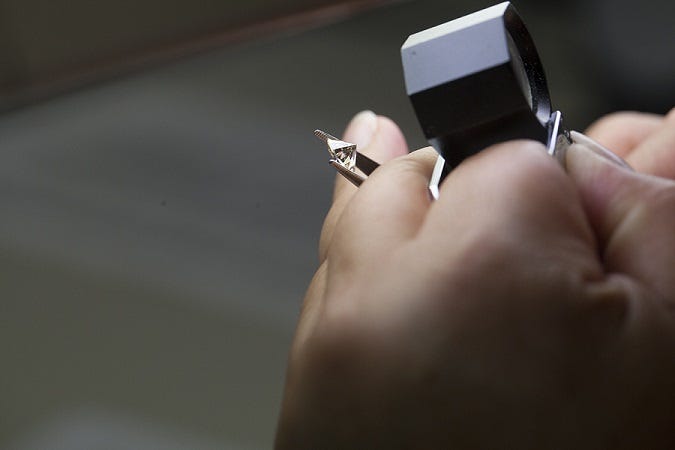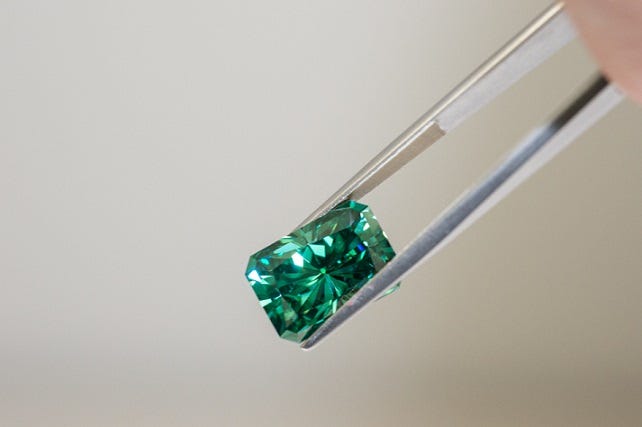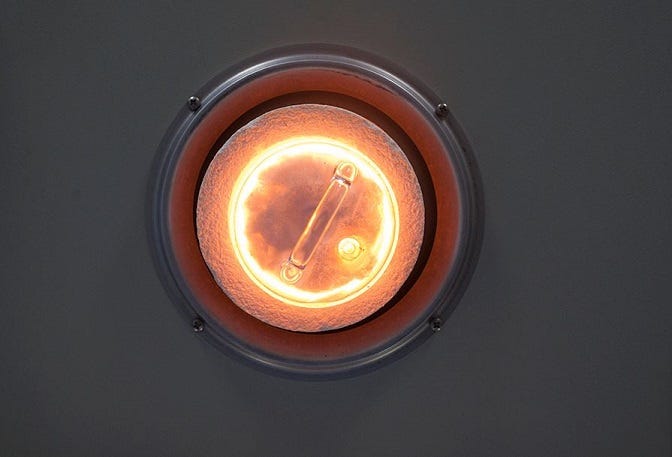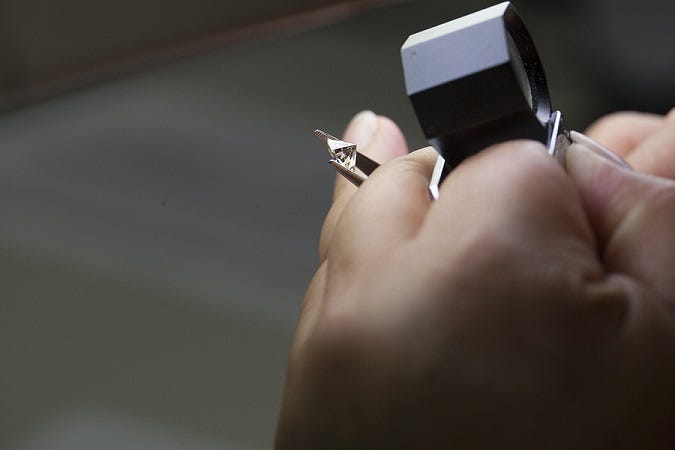
Want to become a Moissy Expert? You’ll be on your way if you take our Moissanite 101 course, which entails simply reading the rest of this post!
Without further ado, here are some commonly asked questions about moissanite and their answers.
HOW DOES CHARLES & COLVARD® CREATE MOISSANITE?
A patented thermal growing process is used to create single-crystal moissanite. The process is lengthy, complicated and expensive, which limits the output (it takes 2-3 months for the creation of a single gem). Charles & Colvard® proprietary patents for the manufacturing process and for moissanite’s use as a gem, currently make Charles & Colvard® the sole source and global distributor of created moissanite.
IN CREATING MOISSANITE, WHAT STEPS ARE TAKEN TO ENSURE THE PRODUCT IS OF THE HIGHEST QUALITY?
Years of development have established a rigorous process for the production of created moissanite that follows exacting specifications and extremely high standards of quality control. The Charles & Colvard® Certificate of Authenticity certifies that every gem is an original product which was manufactured under meticulously controlled facilities by highly skilled specialists. Post production, all created moissanite undergoes stringent testing for quality and purity, including four rounds of grading, before being released for sale.
WHAT IS IT ABOUT MOISSANITE THAT MAKES IT SPARKLE WITH SUCH EXCEPTIONAL BRILLIANCE?
The most significant optical property affecting a gemstone’s potential brilliance, i.e. sparkle, is what’s known as The Refractive Index, or RI. The RI of moissanite ranges from 2.65 to 2.69, meaning it displays more brilliance than diamond (with an RI of 2.42) or any other popular gemstone, such as ruby (RI 1.77) and sapphire (RI 1.77).
WHAT GIVES MOISSANITE ITS FIRE?
Dispersion refers to the prism effect that occurs when pure white light enters a non-opaque object, breaks into spectral (rainbow) colors, and reflects back to the viewer. Moissanite displays 2.4 times the fire of diamond (0.044) and much more dispersion than ruby (0.018), sapphire (0.018), and emerald (0.014), which gives it a gorgeous depth and flash.
WILL MY MOISSANITE EVER LOSE ITS FIRE?
No, and it’s guaranteed. Charles & Colvard® provides a Limited Lifetime Warranty which states that every Charles & Colvard Created Moissanite® will maintain its fire and brilliance throughout its lifetime. Which is a very, very, very long time.
HOW IS MOISSANITE GRADED FOR CLARITY?
The Charles & Colvard® manufacturing facility is managed by a Graduate Gemologist certified by the Gemological Institute of America. Every gem is studied by a trained gem examiner using a 10x jeweler’s loupe for inclusions that may affect moissanite’s optical performance.
DOES MOISSANITE HAVE INCLUSIONS?
There are needle-like inclusions that can be seen under magnification; however, they are not visible to the naked eye. It’s worth noting that nearly every gem has an inclusion of some sort. They are unique characteristics which occur in the formation of the crystalline structure.
IS MOISSANITE AVAILABLE IN COLORS?
In addition to Classic Moissanite™ and Forever Brilliant®, we offer moissanite treated in a variety of colors, and on occasion, an extremely limited quantity of natural green, gray, blue, and yellow.
WILL MOISSANITE CHANGE COLOR OVER TIME OR FADE?
No. There are no likely situations in which the color of moissanite will be permanently changed. Moissanite does undergo a minor temporary color change when exposed to extreme heat (for example, from a jeweler’s torch during jewelry repair techniques) but with proper bench techniques there is no resulting damage, and moissanite returns to its normal color after the gem cools to room temperature, and its brilliance will never fade. In fact, Charles & Colvard® provides a Limited Lifetime Warranty which guarantees that every stone will maintain its brilliance and fire forever.
ARE MOISSANITE GEMS HAND OR MACHINE CUT?
Because hand-cutting is the only way to create maximum brilliance that intensifies a gem’s ultimate fire, each and every Charles & Colvard Created Moissanite® gemstone is hand-cut by a master gem cutter.
WHAT SHAPES ARE AVAILABLE?
Moissanite is available in thirteen shapes and multiple sizes. The most popular cut continues to be round brilliant, yet fancy cuts such as cushion, emerald, pear, and square are available.
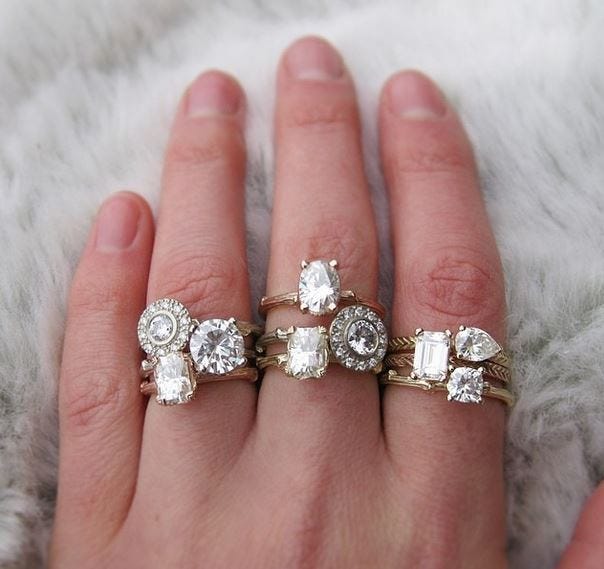
Jewelry designer Kristin Coffin displaying a variety of cuts of moissanite, including round, pear, oval, and emerald
HOW RESISTANT IS MOISSANITE TO SCRATCHING?
Moissanite is durable, tough, and extremely resistant to scratching and abrasion. Diamond is the hardest gemstone used in jewelry (10 on the Mohs scale) but moissanite is only marginally less so, with a hardness of 9.25, and as such is harder than all other gemstones, including ruby and sapphire.
CAN MOISSANITE BREAK EASILY?
Nope. Moissanite is one of the toughest jewels known to mankind. Based on measurable scientific studies in high pressure research, moissanite is extremely resistant to breaking and chipping.
IS IT HEAT TOLERANT?
Moissanite has heat resistance properties superior to many other jewels, including diamond. What else would you expect from a crystalline structure that’s formed at greater than 2000 degrees? Tests prove that at 2000ºF (higher than the equivalent intensity of a house fire) moissanite gems remain intact and as brilliant as the day they were created. This heat tolerance make moissanite far less likely to experience heat damage during jewelry repair.
IDENTIFYING MOISSANITE
Moissanite is so similar to diamond that diagnostic testing equipment had to be invented to distinguish one from the other.
HOW CAN MOISSANITE BE DISTINGUISHED FROM OTHER COLORLESS GEMS?
There are five (5) methods:
- There are testers designed to distinguish moissanite from diamond, with further Research & Development in place to improve detection.
- Determine if doubling of facet junctions is visible through magnification
- Forever Brilliant® stones are engraved on the girdle, which can be viewed with a jeweler’s loupe.
- Examine for unique needle-like inclusions, typically perpendicular to the table facet, which are visible in moissanite under 10x loupe magnification.
- A gemologist using appropriate equipment can identify moissanite by examining for specific refractive and gravity indices.
IS IT TRUE THAT CREATED MOISSANITE CAN TEST POSITIVE AS DIAMOND WITH SOME CONVENTIONAL EQUIPMENT?
Yes. The physical properties of near-colorless created moissanite are very similar to diamond, and moissanite will test positive for diamond on a thermal diamond tester.
PURCHASING OF MOISSANITE
WHY IS MOISSANITE SOLD BY MILLIMETER AND NOT BY CARAT WEIGHT?
Moissanite is listed in millimeters because it is easier for a jeweler to order moissanite in millimeters in order to determine the size needed for mounting.
Carat is the traditional measuring unit of a diamond’s weight. Moissanite stones are slightly lighter than diamonds. For example, a 6.5mm round diamond would weigh 1.0 ct, while a 6.5mm round moissanite would weigh 0.88 ct. The two stones would be the same size – 6.5mm in diameter. All stones for sale are listed with their actual size in mm and/or the diamond equivalent weight in carats.
JEWELRY REPAIR AND CLEANING
HOW ARE MOISSANITE GEMS AND JEWELRY CLEANED?
You can clean moissanite the same way you would diamond or any other fine gemstone. As with any fine jewelry item, an ultrasonic cleaner can be used (but be gentle with your valuable treasures – do not simply toss all your jewelry in at once to guard against possible chipping). Your moissanite gem is perfectly safe under normal ultrasonic cleaning. You can also clean them with a commercial (non-acid based) jewelry cleaner or mild soap and water using a soft toothbrush.
HOW DOES MOISSANITE HOLD UP IN REPAIRS AND SIZING?
Moissanite is a highly stable material. It is durable and tough, extremely resistant to scratching, abrasion, breaking, or chipping. Its high heat tolerance makes moissanite far less likely to experience heat damage during jewelry repair.

